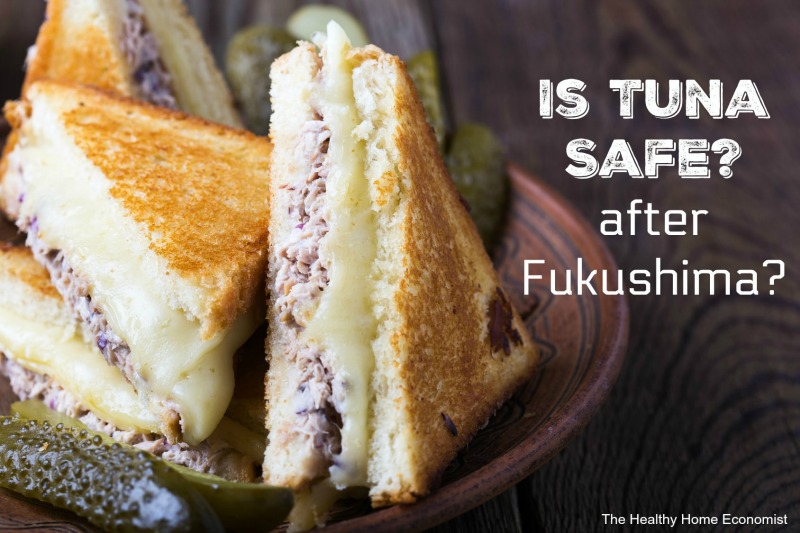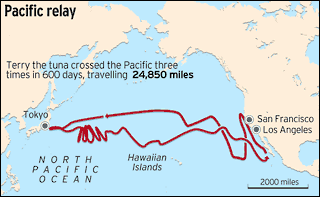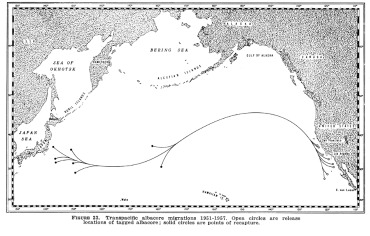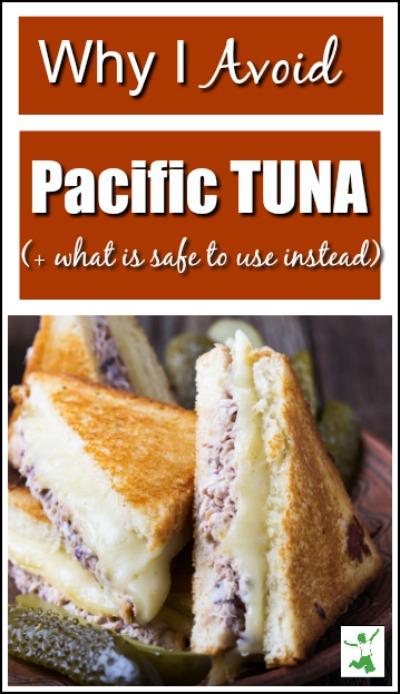
Tuna has always been a staple Real Food in our home. I’ve always taken care to source low mercury, sustainably caught tuna in order to prepare quality tuna steaks for dinner, tuna melts for lunch, or that old standby tuna salad for lunch boxes, quick snacks or just a dollop on a bed of greens. Spicy bluefin tuna rolls are a favorite of my husband when dining at Japanese restaurants.
About a year ago, however, I started to question my choice of tuna for regular consumption. I began reading the reports about the spreading radiation plume in the Pacific from the continuing Fukushima nuclear disaster. I delved into the migratory patterns of various species of tuna. The more I read, the more concerned, and quite frankly, confused I became.
Realizing that my family’s health can’t be wagered on guesses or half-truths, I gathered as much information as I could to arrive at an informed decision. Here’s what I found.
All species of tuna are highly migratory. This means that they swim long distances pretty much throughout their entire lives. These migration patterns are still ill-understood although it is generally agreed upon that they are large.

Pacific bluefin tuna are born near Japan spending their early months swimming in the radiation plume there. They then swim back and forth across the Pacific their entire lives. One tuna nicknamed Terry crossed the Pacific no less than 3 times in the span of only 20 months coming very close to Japan each time. To the right is a chart showing his epic swim.
The information gleaned from Terry the tuna is not new. As early as the 1950’s, tagged albacore tuna were known to swim thousands of miles as shown in this second chart to the right. The open circles off the California coast indicate where they were released and the solid circles closer to Japan indicates where they were recaptured.
 Highly migratory indeed!
Highly migratory indeed!
Atlantic based tuna exhibit the same nomadic patterns. According to National Geographic, high tech tags of Atlantic bluefin tuna revealed the following:
A team of international scientists documented two giant bluefins tagged within minutes of each other off the coast of Ireland. The two fish swam to opposite sides of the Atlantic Ocean–ending up more than 3,000 miles (5,000 kilometers) apart. One of the fish traveled 3,730 miles (6,000 kilometers) southwest to waters about 186 miles (300 kilometers) northeast of Cuba. The other remained in the eastern Atlantic and moved off the coasts of Portugal.
According to the Food and Agriculture Organization of the United Nation (FAO)s, all species of tuna, not just bluefin and albacore, are considered highly migratory, again with the reasons for these patterns not well understood. Here is a breakdown of the tuna species and where they are located according to a report by the FAO:
- Albacore tuna (Thunnus alalunga), which occurs in tropical and temperate waters worldwide.
- Bluefin tuna (Thunnus thynnus), mostly found in temperate waters of the Atlantic, including the Mediterranean, and Pacific Oceans. It is noted that since the adoption of UNCLOS, bluefin tuna in the northern Pacific has been identified as a different species, Pacific bluefin tuna (Thunnus orientalis) while bluefin in the Atlantic has been re-named Atlantic bluefin tuna.
- Bigeye tuna (Thunnus obesus), found in the Atlantic (but absent from the Mediterranean), Indian and Pacific Oceans.
- Skipjack tuna (Katsuwonus pelamis) with a worldwide distribution in tropical and temperate waters.
- Yellowfin tuna (Thunnus albacares), also with a worldwide distribution in tropical and sub-tropical more temperate seas, but absent from the Mediterranean.
- Blackfin tuna (Thunnus atlanticus) found in the western Atlantic in tropical and warm seas.
- Little tuna (Euthynnus alleteratus and E. affinis), with E. alleteratus found in tropical and subtropical waters of the Atlantic, including the Mediterranean, the Black Sea, the Caribbean Sea and the Gulf of Mexico, and E. affinis in the Indian and Pacific Oceans. It is noted that presently, E. alleteratus is called little tunny and E. affinis is called kawakawa.
- Southern bluefin tuna (Thunnus maccoyii), in temperate waters of the southern hemisphere in the Atlantic, Indian and Pacific Oceans.
- Frigate and bullet tuna (Auxis thazard and A. rochei) found in the Atlantic (including the Mediterranean Sea where only A. rochei is found), Indian and Pacific Oceans.
So Tuna Swim. A Lot. So What?
The fact that tuna swim great distances, constantly moving and migrating means that tuna in the Pacific more than likely will have passed through the growing Fukushima radiation plume at some point in their lives, probably numerous times.
With long-lived varieties like albacore (11-12 years) and bluefin (up to 20 years), this is especially true. With much smaller, shorter-lived tuna like the skipjack (about 8 years), less so.
Is the Fukushima Radiation Even Really a Problem?
The answer to this question depends on who you ask. Some reports say yes, the Pacific-based radiation plume from Fukushima is a serious problem and growing worse as 300 tons of radioactive water pours into the Pacific every single day with no end in sight for years. Unbelievably, Japan’s government only acknowledged the urgency of the situation in September 2013.
On the other hand, a comprehensive assessment by the World Health Organization (WHO) concluded that radioactive particles that are making their way to North American waters will have a limited effect on human health, with concentrations below WHO safety levels.
The most unsettling data to date is that the continued outflow of radioactive water from Fukushima now no longer just contains cesium isotopes. It now also contains the more worrisome strontium-90 which is a bone-seeking isotope.
Who is right? Who is wrong?
One thing is true, Fukushima is a nuclear disaster never before experienced in human history so all theories and probabilities are on the table.
Dr. Ken Buessler, a world expert in marine radioactivity with the Woods Hole Oceanographic Institution in Massachusetts who is leading an international research team tracking Fukushima’s trails in the Pacific has this to say:
We still don’t know the answers to many important questions concerning the impacts of Fukushima radionuclides on the oceans. For example, we still don’t have a good handle on how much radioactivity was released, and we don’t fully understand where it has ended up, and that holds for the ocean waters, seafloor sediments, and for marine biota, such as tuna.
Caution Seems to Be the Best Policy
Having personally known someone who died of radiation-induced cancer 15 years after the Chernobyl disaster from the fallout that blanketed parts of Europe which governments at the time said was no threat to human health (his wife lost most of her hair but has survived although they tragically had a daughter born a few years after the disaster who developed leukemia), I don’t take the long term, cumulative effects of radiation lightly and interpret official reports like the one published by the WHO with a grain of salt.
If you choose to interpret the data as a nonthreat to human health with the radiation levels within safe limits, that is, of course, your choice. My approach is both practical and cautionary to play it safe for my children’s sake until more information is gathered and the extent of the problem studied further. This includes avoiding all tuna from Pacific waters given that this particular migratory fish is prone to swimming close to Japan multiple times during its lifetime.
Since much of the time, the ocean of origin for tuna is unknown or not labeled, this would mean avoiding all tuna in most cases. This is exactly what I’ve been doing for the past six months or so – no tuna in my home. Period.
The complaining of my family about the absence of tuna dishes (which everyone loves) has caused me to continue to search for a source of tuna I would feel comfortable serving. I recently discovered a skipjack tuna from Portugal (source) that I’ve been purchasing for several years.
Buy Atlantic Based Tuna!
Given that Atlantic based tuna do not enter the Pacific during their lives, I felt at this time, this brand of sustainably-fished Atlantic tuna would be safe to eat.
However, predictions are for the Fukushima radiation plume to continue growing, eventually entering the Arctic and then the Atlantic Oceans, as the disaster is far from contained. As a result, this situation most likely will change in the coming years. For now, however, if tuna origin can be accurately confirmed, I will purchase and eat it – but only from the Atlantic Ocean and other non-Pacific sources.
What are your thoughts about eating tuna and other seafood? What data have you come across to support your decision? Do you continue to eat tuna? Why or why not?

References
(1) Radiation From Fukushima Could Help Solve the Mystery of Bluefin Tuna Migration
(2) Health risk assessment from the nuclear accident after the 2011 Great East Japan earthquake and tsunami, based on a preliminary dose estimation
(3) Tagged Tuna Reveal Migration Secrets
(4) Tuna’s 25,000 Mile Swim Down Marine Highway
(5) The Migration, Age, and Growth of Pacific Albacore (1951-1958)
(6) Should you Worry about Radiation in your Wild Pacific Fish?
(7) Highly Migratory Species of Fish
(8) Tuna Species








Have stayed away from seafood. Playing it safe.
Sometimes when I want an alternative view I go to cfact.org. They’ve done a few articles about Fukushima. Here’s one:
http://www.cfact.org/2014/01/07/true-facts-about-ocean-radiation-and-the-fukushima-disaster/
BTW- Don’t trust Tepco or the Japanese Government for whatever they say about the disaster, just figure it’s a thousand times worse!! http://enenews.com/kyodo-massive-amount-of-fukushima-radiation-data-could-be-wrong-figures-cannot-be-trusted-nhk-strontium-90-in-groundwater-close-to-ocean-160000-times-limit-actual-levels-had-exceed
Well you sure as heck can’t trust the WHO, let alone our government. There is no end in site to this disaster, it will be ongoing until we die. They have no way to fix this, they don’t know how. The fish are swimming in MOX fuel, cesium, Plutonium, and Strontium which gets in your bones and causes cancer. I think if you eat anything out of the sea you are playing Russian roulette! I will not eat anything out of the sea anymore. The whole world is becoming tainted from Fukushima…not just the west coast, but all the way to Florida, and really the entire northern hemisphere. Please don’t rely on the government for testing, do your own research. Even if they did test I they would not publish accurate data.
Very informative article, am going to share it so all those friends & family who think I’m a kook can read a well researched article on the subject.. I personally quit eating any Pacific seafood months ago, after learning just how dangerous the Pacific coast really is. It’s been a bit a bit of a hardship here too as my family also enjoys all seafood. Oh well, my cousin developed a seafood allergy in her 40s, so if she can give it up, so can we. Also kind of sad because we live in the Puget Sound area and used to send fresh seafood to friends & relatives out of state. We have a wonderful local market that will air express it overnight so it arrives fresh. Gone are the good old days!
This article is anything but well-researched. it is pure speculation and made up nonsense.
There has been some scientific inveestigation of radiation levels in tuna. And the findings are that the levels are very low, lower than the natural radiation that occurs in bananas.
http://www.pnas.org/content/early/2013/05/30/1221834110.full.pdf#sthash.QGR76Yt1.dpuf
The natural radiation in bananas is not the same as the dangerous isotopes contaminating the Pacific from Fukushima. As mentioned in the article, the continued daily outflow of 300 million gallons per day now contains strontium-90 which is a bone seeking isotope even worse than the cesium radionuclides. Not all radiation is equal any more than the hollow argument dentists use that walking to your car you get more radiation from the sun than the dental xrays they try to push on you every 6 months.
Just too funny. Well more tuna for me.
You must be a paid shill.
My reply to you is, eat the fish. Go ahead.
This article is very well written and my comment is not intended toward you Sarah. However, after everything I’ve read about Fluoride and Chlorine in the water (among other contaminates), GMOs, pesticides, herbicides, Meat contaminated with antibiotics and the human growth hormones not to mention cloning and finally what I just read about geoengineering and the air we breath, I found that the best thing to do to avoid being poisoned or exposed to these contaminates is to stop eating, drinking and breathing. I don’t know about anyone else but, I’m tired of worrying about every little thing and I don’t have anywhere near the amount of money it takes to buy all the “good” foods/products so, I’m just going to put my life and times into the Lords hands and be done with it. God Bless and goodnight. 🙂
P.S. Sarah, I really enjoy your blog, all your posts and recipes have been awesome. My comment is generalized and not intended toward any one person.
Thankfully there is also the option to set up an aquaponics system in your backyard (or even in-doors if you wanted). Homegrown veggies and fish that feed eachother! Crazy as that may seem, until people realize how bad things are. And if they’re not really as bad as we think, well, congratulations, you’ve become more self sufficient and aren’t making your food travel thousands of miles to get to your plate. Obviously not everyone can do that, however by some estimates, if just 10% of people had gardens there would be plenty of food for everyone. Now add aquaponics to that and we’re all set!
Maybe some genius will create fish farms based on this system so the farmed fish will be as nutritious as the wild caught, without the heavy metals etc.! I wonder what types of fish can be raised this way though. ponderous…
FINALLY – a voice of reason. I cannot understand how anyone could trust the gov’t or rely on “well we just don’t know” and feel it’s safe to eat from the Pacific. We are finished eating from the sea for now. The Gulf is tainted, the Pacific is tainted and I don’t see it getting better in several lifetimes.
Does this affect tuna fish only or other species as well?
All sea life is affected. The very food, plankton, is contaminated, now.
The only safe place to eat fish is from aquariums like Chicago’s Shedd. I wonder who is privileged to eat the excess or if that is their ($$$) private food source.
i stopped eating tuna well before fukushima